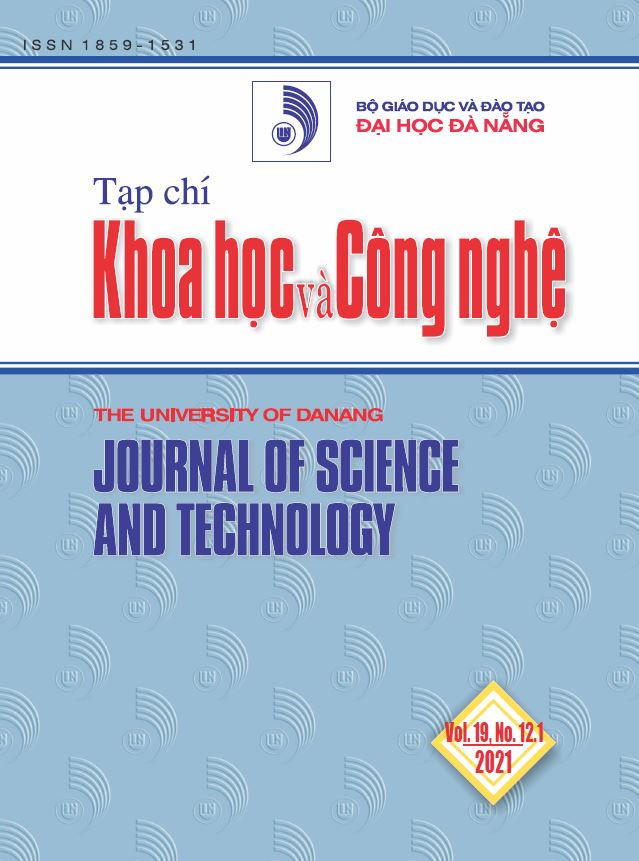Enhanced removal of phosphate from wastewater by precipitation coupled with flocculation
 Tóm tắt: 112
Tóm tắt: 112
 |
|  PDF: 128
PDF: 128 
##plugins.themes.academic_pro.article.main##
Author
-
Ho Hong Quyen
Từ khóa:
Tóm tắt
Eco-friendly flocculants of alginic acid, NaHCO3 and CaCl2.2H2O with advantages of strong gelation characteristics were prepared for supporting the removal of phosphate in synthetic wastewater using CaO and Ca(OH)2 as precipitants. The effects of weight ratios of each component in flocculants, dosage of flocculants and initial phosphate concentration were investigated through batch of experiments. The results showed excellent flocculation performance with the weight ratio of alginic acid:NaHCO3 and CaCl2.2H2O at 1:0.3:0.02 and the dosage of flocculants at 0.0050 g/25 mL of phosphate solution in the range of initial phosphate concentration from 50 to 1000 ppm. Comparing to the sample without flocculants, the phosphate removal efficiency using CaO and Ca(OH)2 with the addition of flocculants increased from 19 and 20% to 97% at the initial phosphate concentration of 50 ppm, respectively by filtration of filter paper 2.7 μm.
Tài liệu tham khảo
-
[1] B. Wang, M. Xin, Q. Wei, L. Xie, “A historical overview of coastal eutrophication in the China Seas”, Marine Pollution Bulletin, 136, 2018, 394-400.
[2] M. B. Djihouessi, B. A. Tigo, M. P. Ain, “The use of nutrient budget approach for informing eutrophication management in urbanised shallow coastal lakes: A case study from Lake Nokoué in Benin”, Ecohydrology & Hydrobiology, 21, 2, 2021, 341-353.
[3] G. Vigouroux, E. Kari, J. M. Beltrán-Abaunza, P. Uotila, D. Yuan, G. Destouni, “Trend correlations for coastal eutrophication and its main local and whole-sea drivers – Application to the Baltic Sea”, Science of The Total Environment, 779, 2021, 146367.
[4] L. Zhao, F. Yang, X. Yan, “Eutrophication likely prompts metal bioaccumulation in edible clams”, Ecotoxicology and Environmental Safety, 224, 2021, 112671.
[5] J. Cui, Z. Jin, Y. Wang, S. Gao, Z. Fu. Y. Yang. Y. Wang, “Mechanism of eutrophication process during algal decomposition at the water/sediment interface”, Journal of Cleaner Production, 309, 2021, 127175.
[6] M. Strokal, T. Kahil, Y. Wada, J. Albiac, Z. Bai, T. Ermolieva,
[7] S. Langan, L. Ma, O. Oenema, F. Wagner, X. Zhu, C. Kroeze, “Cost-effective management of coastal eutrophication: A case study for the Yangtze river basin”, Resources, Conservation and Recycling, 154, 2020, 104635.
[8] S. S. Lin, S. L. Shen, A. Zhou, H. M. Lyu, “Assessment and management of lake eutrophication: A case study in Lake Erhai, China”, Science of The Total Environment, 751, 2021, 141618.
[9] S. N. Levine, A. Lini, M. L. Ostrofsky, H. B. Grant, A. Lami, E. C. Gilles, D. Reuter, L. S. Miller, N. Kamma, “The relative roles of point and nonpoint phosphorus sources in the eutrophication of Lake Champlain as recorded in sediment cores”, Journal of Great Lakes Research, 44, 2018, 1043-1056.
[10] Q. Yana, T. Cheng, J. Song, J. Zhoud, C. C. Hung, Z. Cai, “Internal nutrient loading is a potential source of eutrophication in Shenzhen Bay, China”, Ecological Indicators, 127, 2021, 107736.
[11] B. An, S. Lee, H.-G. Kim, D. Zhao, J.-A. Park, J.-W. Choi, “Organic/inorganic hybrid adsorbent for efficient phosphate removal from a reservoir affected by algae bloom”, Journal of Industrial and Engineering Chemistry, 69, 2019, 211-216.
[12] G.K. Morse, S.W. Brett, J.A. Guy, J.N. Lester, “Review: Phosphorus removal and recovery technologies”, The Science of the Total Environment, 212, 1998, 69-81.
[13] H. Bacelo, A. M. A. Pintor, S. C. R. Santos, R. A. R. Boaventura,
[14] C. M. S. Botelho, “Performance and prospects of different adsorbents for phosphorus uptake and recovery from water”, Chemical Engineering Journal, 381, 2020, 122566.
[15] C. K. Mbamba, E. Lindblom, X. F. Alsina, S. Tait, S. Anderson, R. Saagi, D. J. Batstone, K. V. Gernaey, U. Jeppsson, “Plant-wide model-based analysis of iron dosage strategies for chemical phosphorus removal in wastewater treatment systems”, Water Research, 155, 2019, 12-25.
[16] O. Gutierrez, D. Park, K. R. Sharma, Z. Yuan, “Iron salts dosage for sulfide control in sewers induces chemical phosphorus removal during wastewater treatment”, Water Research, 44, 2010, 3467-3475.
[17] J. Thistleton, T. A. Berry, P. Pearce, S. A. Parsons, “Mechanisms of Chemical Phosphorus Removal II: Iron (III) Salts”, Process Safety and Environmental Protection, 80, 2002, 265-269.
[18] S.H. Yeom, K.-Y. Jung, “Recycling wasted scallop shell as an adsorbent for the removal of phosphate”, Journal of Industrial and Engineering Chemistry, 15, 2009, 40-44.
[19] Ho Hong Quyen, Tran Vu Chi Mai, “High efficient removal of phosphate in aqueous solution by eco-friendly materials”, The University of Danang - Journal of Science and Technology, Vol. 19, No. 6.1, 2021, 7-12.
[20] X. Guo, Y. Wang, Y. Qin, P. Shen, Q. Peng, “Structures, properties and application of alginic acid: A review”, International Journal of Biological Macromolecules, 162, 2020, 618-628.
[21] W. Jeon, C. Ban, G. Park, H. C. Woo, D. H. Kim, “Hydrothermal conversion of alginic acid to furfural catalyzed by Cu(II) ion”, Catalysis Today, 2016, 154-162.
[22] E. Grządka, J. Matusiak, E. Godek, “Alginic acid as a stabilizer of zirconia suspensions in the presence of cationic surfactants”, Carbohydrate Polymers, 246,2020, 116634
[23] P. L. Sanchez, N. Fredriksson, A. Larsson, A. Altskär, A. Ström, “High sugar content impacts microstructure, mechanics and release of calcium-alginate gels”, Food Hydrocolloids, 84, 2018, 26-33.
[24] A. Maureira, B.L. Rivas, “Metal ions recovery with alginic acid coupled to ultrafiltration membrane”, European Polymer Journal, 45.
[25] T. Ramdhan, S.H. Ching, S. Prakash, B. Bhandari, “Time dependent gelling properties of cuboid alginate gels made by external gelation method: Effects of alginate-CaCl2 solution ratios and pH”, Food Hydrocolloids, 90, 2019, 232-240.
[26] K.A. Bowman, O.A. Aarstad, M. Nakamura, B.T. Stokke, G. Skjåk-Bræk, A.N. Round, “Single molecule investigation of the onset and minimum size of the calcium-mediated junction zone in alginate”, Carbohydrate Polymers, 148, 2016, 52-60.



